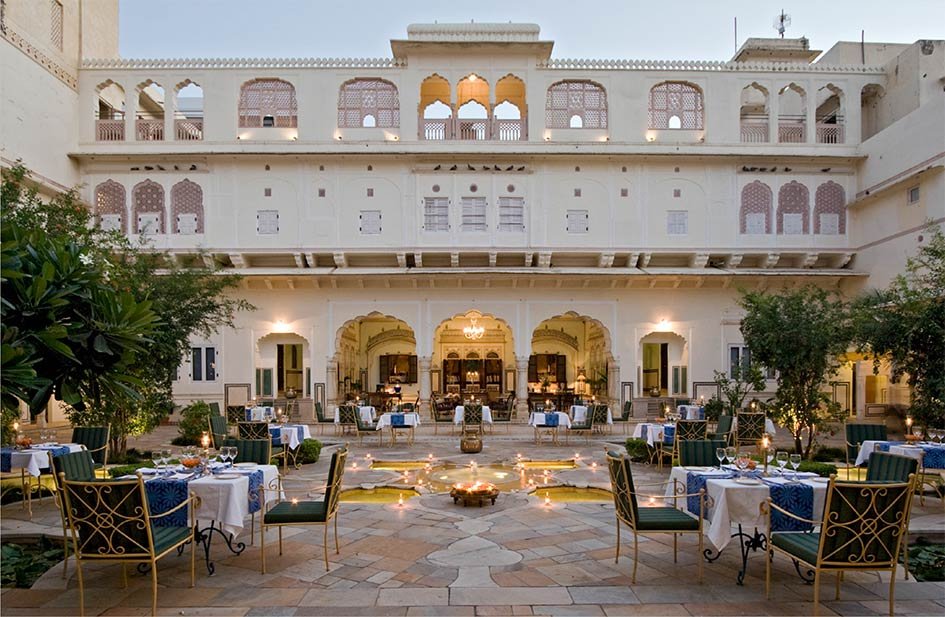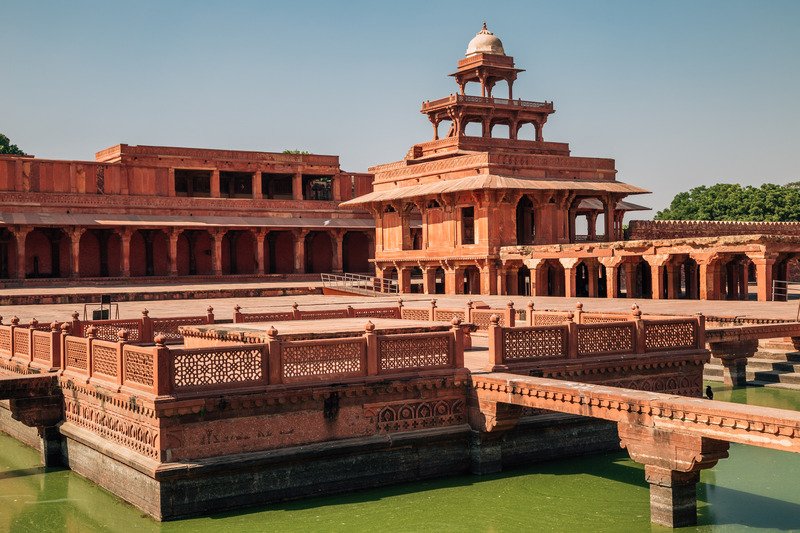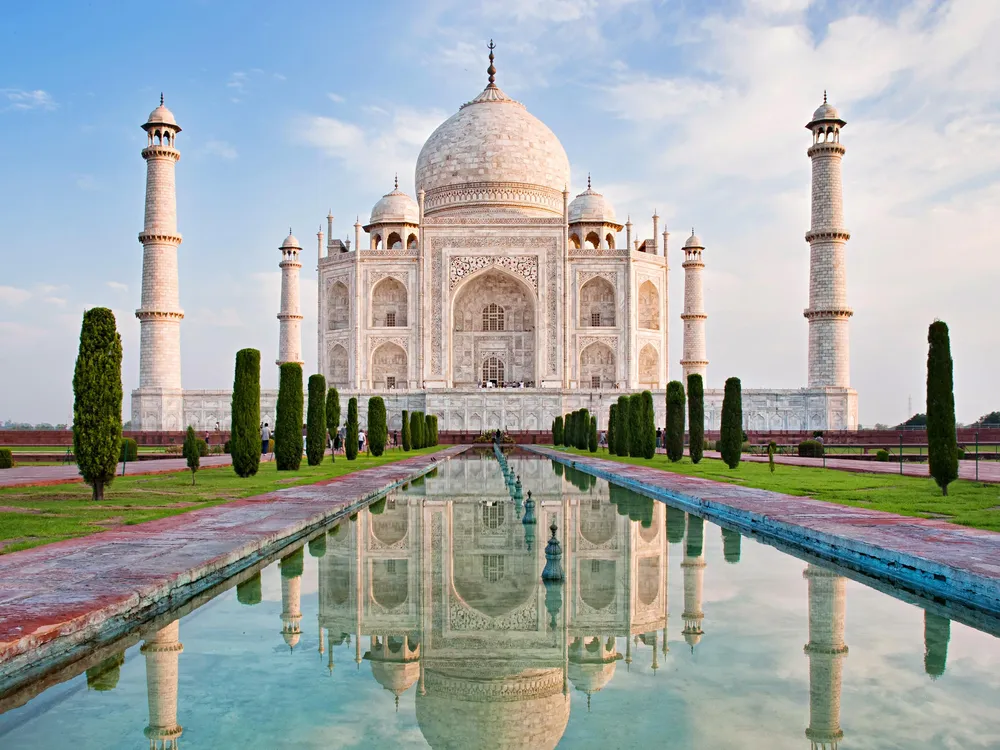India
Golden Triangle with Varanasi and Kathmandu
The Tour at a Glance
India is renowned for its vibrant colours and rich cultural heritage. The Golden Triangle tour, which includes Delhi, Jaipur, and Agra, is the shortest yet most captivating journey through North India. This enhanced tour also includes the sacred city of Varanasi and the historic capital of Nepal, Kathmandu, adding even more depth and diversity to the experience.
The Golden Triangle is a famous tourist route encompassing Delhi, Agra, and Jaipur. On a map, these cities form an almost equilateral triangle, earning the name “golden” due to the wealth of cultural and historical attractions within.
Delhi is the starting point of the Golden Triangle, celebrated for its stunning architectural monuments, lush Mughal gardens, and poignant memorials. Next is Agra, known as the “home of heritage sites,” which captivates visitors with the breathtaking beauty of the Taj Mahal, one of the Seven Wonders of the World. The final stop in the traditional Golden Triangle is Jaipur, the enchanting pink city, which wonderfully exemplifies the warm hospitality and royal heritage of Rajasthan.
Extending beyond the Golden Triangle, Varanasi offers a deeply spiritual experience with its sacred Ganges River and ancient temples, providing a unique glimpse into India’s religious traditions. The journey concludes in Kathmandu, Nepal’s historic capital, where visitors can explore its rich cultural heritage, stunning temples, and the vibrant local life nestled in the Himalayas.
This expanded itinerary promises an unforgettable exploration of some of the most fascinating and diverse regions in South Asia.
Overview
Overview
The Tour at a Glance
India is renowned for its vibrant colours and rich cultural heritage. The Golden Triangle tour, which includes Delhi, Jaipur, and Agra, is the shortest yet most captivating journey through North India. This enhanced tour also includes the sacred city of Varanasi and the historic capital of Nepal, Kathmandu, adding even more depth and diversity to the experience.
The Golden Triangle is a famous tourist route encompassing Delhi, Agra, and Jaipur. On a map, these cities form an almost equilateral triangle, earning the name "golden" due to the wealth of cultural and historical attractions within.
Delhi is the starting point of the Golden Triangle, celebrated for its stunning architectural monuments, lush Mughal gardens, and poignant memorials. Next is Agra, known as the "home of heritage sites," which captivates visitors with the breathtaking beauty of the Taj Mahal, one of the Seven Wonders of the World. The final stop in the traditional Golden Triangle is Jaipur, the enchanting pink city, which wonderfully exemplifies the warm hospitality and royal heritage of Rajasthan.
Extending beyond the Golden Triangle, Varanasi offers a deeply spiritual experience with its sacred Ganges River and ancient temples, providing a unique glimpse into India's religious traditions. The journey concludes in Kathmandu, Nepal's historic capital, where visitors can explore its rich cultural heritage, stunning temples, and the vibrant local life nestled in the Himalayas.
This expanded itinerary promises an unforgettable exploration of some of the most fascinating and diverse regions in South Asia.
Itinerary
Itinerary Expand All
Day 1
Delhi Jaipur Agra Varanasi Kathmandu DAY - 1ARRIVAL DELHI (BY INTERNATIONAL FLIGHT)
Arrive in Delhi, after completing immigration and customs formalities, and meet our representative at the arrival gate. After introductions, you will be transferred to the hotel.
DELHI, the capital of India, is home to 16 million people, making it the third largest city in India. The strategic location of the city made it an attractive location for invading armies, and it served as the capital for many great empires that ruled India. Many of these Empires built significant monuments, and whilst the Mughal and the British are the most visible while driving through the city you will see ruins from previous capitals, the earliest dating back to the 12th century.
Overnight at Hotel
- Breakfast ( Continental PlanDay 2
DELHI (SIGHTSEEING )
Breakfast at the hotel.
Morning proceeds for your tour of OLD DELHI.
Start your visit to Raj Ghat, a simple memorial to Mahatma Gandhi. He is also famously known as the “father of the nation”. Continue your tour to Jama Masjid, one of Asia’s largest mosques. People stream in and out of the mosque continuously and the presence of a nearby bazaar means that the area is rarely quiet. Enjoy the rickshaw ride at Old Delhi peddling through the narrow lanes of Chandani Chowk and visit the spices market one of the largest wholesale spice markets in Asia, it is well worth a visit for the intensity of its sights and smells alone. Along with fresh spices of all shapes, sizes, and colors, this market sells myriad nuts, herbs, dry fruits, and grains.
Lunch on your own.
In the afternoon drive past British Architect Edward Lutyens, with the task of building the new capital in Delhi. Lutyen’s Delhi primarily consists of the administrative area of the capital, Parliament House, India Gate, and the Viceroy’s House (which is now known as Rashtrapati Bhawan). A visit to Delhi is incomplete without going to Lutyen’s Delhi which one can say, is the place where the Central Government of India currently resides and works from. Afterwards, visit Humayun Mausoleum, the 2nd Mughal emperor. Built in the middle of the 16th century at the request of Hamida Banu Begum (the widow of Emperor Humayun), the mausoleum is a fine example of early Mughal architecture.
Later visit QUTAB MINAR which dominates the historic site where Qutb-ud-Din-Aibak laid the foundation of the Delhi Sultanate. Its sandstone minaret, 72.5 m high, has a staircase of 379 steps to reach the summit. It is the tallest stone tower in India and one of the most successful Muslim buildings. You will then discover the Humayun Mausoleum, the 2nd Mughal emperor. Built in the middle of the 16th century at the request of Hamida Banu Begum (the widow of Emperor Humayun), the mausoleum is a fine example of early Mughal architecture.
The balance of the day is at leisure.
Overnight at Hotel
- Breakfast ( Continental Plan )Day 3
DELHI-SAMODE-JAIPUR (250 KMS - 05 HRS DRIVE )
Breakfast at the hotel.
After Breakfast You will travel to Samode, Samode Royal Majesty Nestled among the rugged yet beautiful Aravalli Hills, this enchanting village is ideal for leisurely walks and holds interest for ancient art, culture, local crafts, and the aesthetic beauty of havelis and forts. The magnificent Samode Palace is a remarkable heritage hotel. It was not until the early 1800s under Rawal Berisal that the palace began to attain the grandeur it is known for today, and was further expanded under his successor Rawal Sheo Singh, Who is considered to be the palace’s most magnificent addition-an abundance of flowers painted Darbar Hall and a viewing gallery that forms an incredible hall of mirrors, the magic of which is replicated in the famous palaces of Rajasthan.
Lunch at Samode Palace.
After Lunch, explore Samode village then proceed to Jaipur, on arrival check in at the hotel. The rest of the day is free at leisure.
Overnight at Hotel
- Breakfast ( Continental Plan )Day 4
JAIPUR (SIGHTSEEING)
Breakfast at the hotel.
Morning proceeds for the sightseeing tour of Jaipur visiting Amer Fort with Elephant Ride. En route stop for a photo shoot in front of The Hawa Mahal a palace in the city of Jaipur, India. Built from red and pink sandstone, it is on the edge of the city Palace, Jaipur, and extends to the Zenana, or women’s chambers. Hawa Mahal. Also Known as the “Palace of Breeze” was built in 1799 as an extension of the City Palace.
Later, proceed to visit the city of Amber and its fort. Erected on a vast hill, the citadel and its fort were intended to protect the ancient capital of the state of Jaipur. You will get there on the back of an elephant. Explore the majestic Amer Fort. You will be able to visit the various rooms, the inner courtyards, the rooms of public hearings, and the Mughal gardens with their star-shaped flower beds. In addition, Amber Fort offers panoramic views of Lake Maota. After your visit, return down the hill through Jeep.
Lunch at a Local restaurant.
Afternoon, proceed to visit City Palace one of the major landmarks in Jaipur. The beautiful palace was built by Maharaja Sawai Jai Singh during his reign. Among the various forts and palaces of Jaipur, City Palace stands apart, with its outstanding art and architecture. In the Palace complex visit Maharaja Sawai Man Singh II Museum.
Visit to Observatory or Jantar Mantar. It is an astronomical observation site built in the early 18th century by King whose passion for science, engineering, and astronomy prompted him to construct this complex of fourteen scientific instruments. It’s been over 200 years since they were first constructed, and these fourteen structures can still accurately measure time; predict eclipses, and track stars and planets in their orbits.
Time free for shopping. Jaipur is quite famous for handicrafts and Jewellery.
After shopping, return to the hotel to wash and change.
Evening proceeds for dinner with a local Rajasthani folk dance performance to experience the Rajasthani culture.
Overnight at Hotel
- Breakfast ( Continental Plan )Day 5
JAIPUR-ABHANERI-FATEHPUR SIKRI-AGRA
Breakfast at the hotel.
After Breakfast You will travel by surface to Agra. Enroute visit ABHANERI and Fatehpur Sikri.
ABHANERI: A village in the Dausa region of the Indian state of Rajasthan, also written Abaneri, is called Abhaneri. The Chand Baori step well and the Harshat Mata Temple are two attractions in the old city of Abhangari, whose ruins can be found at Abhaneri. On the Jaipur-Agra Highway is where it is located.
Fatehpur Sikri: Built by the Mughal Emperor Akbar in the mid-16th century, Fatehpur Sikri was meant to be a new capital for his empire. It was also the emperor’s homage to Saint Sheikh Salim Chishti, who predicted the birth of the emperor’s much-desired son and heir. Built in an almost uniform style, Sikri is a sprawling complex of palaces, mosques, temples, and other structures. It is a stunning amalgamation of the Persian and Indian styles of building. Later continue your drive for Agra.
Lunch at Laxmi Villas Palace.
After Lunch, proceed to Agra.
Upon arrival check in at the hotel.
Evening Option: Mohabbat-e-Taj Show
Spend your evening watching the amazing Mohabbat-e-Taj Show depicting the romantic love story of Emperor Shah Jahan and his beloved wife Mumtaj Mahal. It is a live show in Hindi language and interpretation is available in English, French, and German languages through headphones. Over 80 talented artists will perform this love story along with creative dance performances.
Overnight at Hotel
- Breakfast ( Continental Plan )Day 6
AGRA (SIGHTSEEING) + AGRA-DELHI( 220 KMS/04 HRS DRIVE)
Breakfast at the Hotel.
Check out from the hotel and proceed to Visit to Taj Mahal at sunrise. The Taj Mahal is one of the Seven Wonders of the World that symbolizes the love of the Mughal Emperor Shah Jahan for his beloved wife Mumtaz Mahal’s final resting place. The Taj Mahal is widely recognized as "the jewel of Muslim art and one of the universally admired masterpieces of the world's heritage. The white marble building changes its hue with the variations in the daylight. In the moonlight, particularly on the full moon night, the marble appears extraordinarily luminescent.
Lunch on your own.
In the afternoon visit, The Agra Fort is one of the most important and robustly built strongholds of the Mughals, embellished with several richly decorated buildings encompassing the imposing Mughal style of art and architecture. Also visit a marble-inlay workshop to see the intricate work and unique skill which goes into each finely detailed piece of marble inlay, using a number of beautiful semi-precious stones.
Itmad Ud Daulah’s tomb: Nicknamed Baby Taj, was the first Mughal structure built completely from marble. Built between 1622 and 1628, this is the tomb of Mirza Ghiyas Beg, chief minister of Emperor Jehangir and father of Nur Jahan.
Before leaving Agra for Delhi, time is free for shopping. Agra is famous for Marble Artefacts. Visit the Marble factory cum showroom and may shop for some good items there. Afterwards, proceed to Delhi.
Upon arrival check-in at the hotel.
Overnight at Hotel
- Breakfast ( Continental Plan )Day 7
DELHI-VARANASI (FLIGHT- 01 HOUR AND 30 MINUTES)
Breakfast at the Hotel.
After Breakfast, check out from the hotel and transfer to the Airport to connect the flight to Varanasi.
Upon arrival in Varanasi, you will be met by our representative and transferred to the hotel.
Check-in at the hotel.
Evening explore the city walking and enjoy a rickshaw ride and then deboard from Rickshaw and witness the religious ceremony on the Hindu holiest river – The Ganges. Participate in the Holi prayer, which is quite interesting.
- Overnight at Hotel
- Breakfast ( Continental Plan )Day 8
VARANASI(SIGHTSEEING) + VARANASI-DELHI ( FLIGHT )
Breakfast at the Hotel.
Early morning at 0500 Hrs: Proceed to Experience a Boat Ride on River Ganga.
Morning visits to the religious Hindu temples - Bharat Mata temple, Durga temple, and the Tulsi Manas Temple. Later visit the Benares Hindu University.
Return to hotel for Breakfast.
After Breakfast proceed for an excursion to Sarnath, one of the top four Buddhist pilgrimage destinations in the world where the Buddha gave his first sermon. Buddhists look upon India as the land of Buddha which makes Sarnath a popular tourist attraction. The emperor Ashoka, who spread the Buddha’s message of love and compassion throughout his vast empire, visited Sarnath around 234 BC and erected a stupa here. Several Buddhist structures were raised at Sarnath between the 3rd century BC and the 11th century AD. Visit the Archaeological Museum (Closed on Fridays), Asoka Pillar, and the Chinese Buddhist Temple.
Lunch on your own.
Evening time free for shopping. Varanasi is famous for Silk. You can find world-class quality silk.
In time transfer to the Airport to connect flight to Delhi. Upon arrival check in at the hotel.
Overnight at Hotel
- Breakfast ( Continental Plan )Day 9
DELHI-KATHMANDU ( FLIGHT)
Breakfast at the Hotel.
Today, transferred to the airport to board a flight to Delhi. Upon arrival, you will connect the flight to Kathmandu.
Upon arrival in Kathmandu, meet our representative and transfer to the hotel. Upon arrival Check in at the hotel.
Transfer to hotel (Normal check-in time of the hotel is 1400 hours)
Overnight at Hotel
- Breakfast ( Continental Plan )Day 10
KATHMANDU (SIGHTSEEING)
Breakfast at hotel
Early Morning Full day sightseeing tour of Kathmandu Durbar Square, Swayambunath & Patan Durbar Square
Kathmandu Durbar Square - known as Kantipur, the capital of the Kingdom of Nepal. Here you will visit the temple of the Living Goddess, who acknowledges the greetings of the devotees from the balcony of her temple residence. Kasthamandap - the source of the name Kathmandu and supposed to be made from the timber of a single tree and the Durbar Square with its array of temples overlooked by the Hanuman Dhoka Palace, the ancient place of the Nepalese Royalty.
Swayambunath - located approximately 4 km/2.5 miles, Buddhist stupa that is said to be 2000 years old. The stupa which forms the main structure is composed of a solid hemisphere of brick and earth supporting a lofty conical spire capped by a pinnacle of copper gilt. Painted on the four-sided base of the spire are the all-seeing eyes of Buddha. This hill is a mosaic of small Chaityas and Pagoda temples.
Patan City - 5 km/3 miles away from Kathmandu City. Patan also known as Lalitpur, is the city of fine arts, enclosed within 4 stupas said to have been built in the 3rd century AD, by Emperor Ashoka. You will see the Durbar Square, the Patan Durbar which houses a bronze collection, and the Krishna Temple built by King Siddhi Narsingh Malla.
Overnight at Hotel
- Breakfast ( Continental Plan )Day 11
KATHMANDU (SIGHTSEEING)
Breakfast at hotel
Full-day sightseeing tour of Pashupatinath, Boudhnath & Bhaktapur Durbar Square
Pashupatinath - situated 5 km east of Kathmandu city, Pashupatinath temple is one of the holiest Hindu temples dedicated to Lord Shiva. Situated amidst a lush green natural setting on the bank of the sacred Bagmati river, the temple built in pagoda style has a gilted roof and richly carved silver doors. Visitors will be permitted to view the temple from the east bank of River Bagmati, entrance to the temple being strictly forbidden to all non-Hindus. Pashupatinath is the center of the annual pilgrimage on the day of Shivaratri which falls in February/March. Behind the temples are the cremation grounds
Bodhnath - this stupa, eight kilometers east of Kathmandu City is one of the biggest in the world of its kind. It stands with four pairs of eyes in the four cardinal directions keeping watch for righteous behaviors and human prosperity. This Buddhist stupa was built by King Man Deva at the advice of Goddess Mani Jogini. It is built on an octagonal base inset with prayer wheels. The shrine is ringed by houses of Lamas or Buddhist priests.
Bhadgaon - also known as Bhaktapur meaning the city of devotees, this place is the home of medieval art and architecture. Lying 14 km/9 miles east of Kathmandu City, this place was founded in the 9th century and is shaped like a conch shell. The city is at a height of 4600 ft. above sea level. In Bhadgaon you will visit the Durbar Square with its array of temples overlooked by the Palace of 55 windows built by King Bhupatindra Malla. The Nyatapola Temple also built by King Bhupatindra Malla, is the best example of Pagoda style and stands on five terraces on each of which stands a pair of figures two famous strong men, two elephants, two lions, two famous strong men, two elephants, two lions, two griffins and two goddesses.
- Overnight at Hotel
- Breakfast ( Continental Plan )Day 12
KATHMANDU-DELHI FLIGHT TO CONNECT FLIGHT TO ONWARD JOURNEY
Breakfast at the hotel.
After breakfast, check out from the hotel and transfer to the International Airport to connect the flight to the onward destination.
- Breakfast ( Continental Plan )
End Of Tour






















